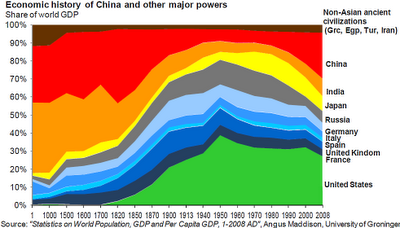WW-1 Prosperity?
"War prosperity" is an odd, but enduring myth. Wars destroy some men and material; and, they divert others from making "butter" to making "guns". Nevertheless, one hears people say things like: "spending lots of money fighting Hitler, brought the U.S. out of depression"(1). Here's a brief look at the FIRST world-war.
Detailed WW-I timeline: Actually, the U.S. did not enter WW-I in 1914. At first, the U.S. was at peace, while producing and exporting to the warring nations. Only in 1917 did the U.S. declare war. Armistice Day was less than 2 years later, in 1918.
Peace prosperity: Consider the top-most black line in this diagram. It is an index of Production volume(2). When we examine WW-I more closely, we find that the so called "war prosperity" was actually a "peace prosperity".
 Production volume boomed from 1914 to 1917. During this period, Europe looked to the U.S. for production. They sold a lot of their investments in the U.S., in order to buy U.S. goods; they sent large volumes of gold to the U.S.; and, added to this, the U.S. government lent money to European nations. In the U.S., commodity prices rose, and wages followed about a year later. Nevertheless, real production volumes rose too. Then, in 1917, the U.S. entered the war. Look at how things flattened out after that.
Production volume boomed from 1914 to 1917. During this period, Europe looked to the U.S. for production. They sold a lot of their investments in the U.S., in order to buy U.S. goods; they sent large volumes of gold to the U.S.; and, added to this, the U.S. government lent money to European nations. In the U.S., commodity prices rose, and wages followed about a year later. Nevertheless, real production volumes rose too. Then, in 1917, the U.S. entered the war. Look at how things flattened out after that.
Europe: By the logic of the "war prosperity" argument, we would expect Europe to do better than the U.S.. After all, they fought longer. They spent a lot too. At a time when the U.S. national product was about $50 billion, economist Brad de Long estimates(3) that the wartime accumulated budgets of all combatants was $200 billion: four times the entire US national product. WW-I devastated Europe, in terms of lives, an estimated $40 billion in property damage, and lost production of $65 billion. It was the U.S. -- thanks to its "peace prosperity" that helped Europe after WW-I.
Notes:
The pro-War case: U.S. production did boom during World War-I. When the war ended in 1918, American production volume was about 25% higher than it had been in 1914. In 1914, the U.S. was a debtor country; by 1918, the positions were reversed: the world owed money to the U.S.
Detailed WW-I timeline: Actually, the U.S. did not enter WW-I in 1914. At first, the U.S. was at peace, while producing and exporting to the warring nations. Only in 1917 did the U.S. declare war. Armistice Day was less than 2 years later, in 1918.
Peace prosperity: Consider the top-most black line in this diagram. It is an index of Production volume(2). When we examine WW-I more closely, we find that the so called "war prosperity" was actually a "peace prosperity".

Europe: By the logic of the "war prosperity" argument, we would expect Europe to do better than the U.S.. After all, they fought longer. They spent a lot too. At a time when the U.S. national product was about $50 billion, economist Brad de Long estimates(3) that the wartime accumulated budgets of all combatants was $200 billion: four times the entire US national product. WW-I devastated Europe, in terms of lives, an estimated $40 billion in property damage, and lost production of $65 billion. It was the U.S. -- thanks to its "peace prosperity" that helped Europe after WW-I.
Notes:
1. I don't claim that serious, professional economists think war is good for the economy; but I have heard this from non-economists.
2. "Economics and the Public Welfare" - Benjamin M. Anderson
3. "Economic History of the Twentieth Century" - Bradford DeLong
2. "Economics and the Public Welfare" - Benjamin M. Anderson
3. "Economic History of the Twentieth Century" - Bradford DeLong

Comments
Post a Comment